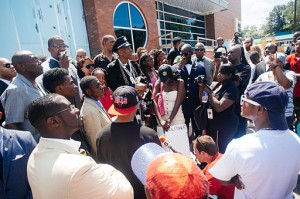![Official White House Photo by Pete Souza (P120612PS-0463 (direct link)) [Public domain], via Wikimedia Commons](http://occupyworldwrites.org/wp-content/uploads/2014/04/512px-President_Barack_Obama-240x300.jpg)
Official White House Photo by Pete Souza (P120612PS-0463 (direct link)) [Public domain], via Wikimedia Commons
When Barack Obama was elected as President of the United States in 2008, the international community rallied together, thinking that America, the country that extolled the values of human rights the world over, had reached a new level in their society and moved beyond their racist past. Many Americans also believed this.
What has actually happened is a much different picture. Few will admit it, and some will utterly deny it, but what has happened is a much more polarized attitude in the population regarding policies and race.
Out of what seemed like nowhere, I noticed an outright rejection of anything that resembled a change in attitudes in certain segments of the culture. We heard the escalation of code words in our language, just so people could avoid using obvious words like race, black, and color. We heard welfare president, food stamp president, lawless thug, Muslim, witch doctor, sub-human mongrel, all in reference to the country’s president.
Michele Bachmann said that slaves came to America for a “better way of life.” Haley Barbour says the “Civil Rights era was not that bad for either side.” Paul Ryan talks about the “inner city culture” that does not have any work ethic at all.
School lunch programs in the south featured fried chicken, collard greens and watermelon during black history month. I suppose we weren’t supposed to think anything of that. We weren’t supposed to notice public funds being taken from public schools to be used in charter school systems instead, leaving most impoverished children with no real education opportunities. In this example, “impoverished” does mean African-American.
“Stand You Ground” laws are an interesting example. 36% of whites using this defense in court win their argument. Only 3% of African-Americans have succeeded in making the same claim. This does not include racial profiling, and the practice of which is so widespread and ingrained that police departments are in denial or not aware of the habit.
I’m not pointing fingers correctly unless I examine my own backyard. In Minnesota, black children are 6 times more likely to be arrested for delinquency, Native-American children 4 times more likely, and minority children overall are 6 times more likely to be arrested. Minority teens are more than four times more likely than whites to be prosecuted as adults, and black teens are more than six times more likely to be prosecuted in adult court than whites. The youth population in Minnesota is about 78 percent white, 8 percent black, and 7 percent Latino. Asian and American Indian youth combined made up 7 percent. Not very non-racist for a state that claims to be color blind.
Blacks are less likely to be hired for a job. They are less likely to be raised in a home that has not been affected by poverty and incarceration of a family member or relative. They are less likely to be able to graduate, less likely to go to college and less likely to be able to run for public office. And yes, they actually are less likely to be elected as president.
All this while we “celebrate” enacting the Civil Rights Act 50 years ago – as if our ACTS are any where CIVIL when it comes to policy, law enforcement and educational opportunities – and what gives anyone the RIGHTS to act in such a way?. Get used to the routine, because we now see another race being clearly discriminated against. Have you heard of Latino-Americans?
“In this country American means white. Everybody else has to hyphenate.” ― Toni Morrison
![Uncle Tom's Cabin, 1st edition, 1852. The Women's Museum, Dallas, Texas (Courtesy Stowe Center Library) By Photo: User:FA2010 (Own work) [Public domain], via Wikimedia Commons](http://occupyworldwrites.org/wp-content/uploads/2014/04/512px-Uncle_Toms_Cabin_1st_edition_Womens_Museum.jpg)
Uncle Tom’s Cabin, 1st edition, 1852. The Women’s Museum, Dallas, Texas (Courtesy Stowe Center Library) By Photo: User:FA2010 (Own work) [Public domain], via Wikimedia Commons
![Little Rock, 1959. Rally at state capitol, protesting the integration of Central High School. Photo by John T. Bledsoe [Public domain], via Wikimedia Commons](http://occupyworldwrites.org/wp-content/uploads/2015/06/512px-Little_Rock_integration_protest.jpg)





![Official White House Photo by Pete Souza (P120612PS-0463 (direct link)) [Public domain], via Wikimedia Commons](http://occupyworldwrites.org/wp-content/uploads/2014/04/512px-President_Barack_Obama-240x300.jpg)
![Uncle Tom's Cabin, 1st edition, 1852. The Women's Museum, Dallas, Texas (Courtesy Stowe Center Library) By Photo: User:FA2010 (Own work) [Public domain], via Wikimedia Commons](http://occupyworldwrites.org/wp-content/uploads/2014/04/512px-Uncle_Toms_Cabin_1st_edition_Womens_Museum.jpg)